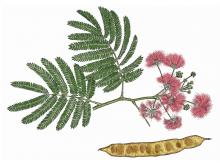Trees, Shrubs and Woody Vines
Media

Species Types
Scientific Name
Koelreuteria paniculata
Description
Golden rain tree is native to China, Korea, and Japan. It was cultivated in Missouri for years. Because it readily escapes from cultivation and is invasive, it is no longer recommended for planting in Missouri.
Media

Species Types
Scientific Name
Gleditsia triacanthos
Description
Though it doesn’t reach a stately size, honey locust commands respect for its many large, strong, usually branched thorns, which can puncture tractor tires as easily as they can poke through tennis shoes! The long, leathery, twisting pods are relished by cattle and by wildlife.
Media

Species Types
Scientific Name
Cercis canadensis
Description
Eastern redbud is a native shrub or small tree that is distinctly ornamental in spring with small, clustered, rose-purple flowers covering the bare branches before the leaves.
Media

Species Types
Scientific Name
Albizia julibrissin
Description
Grown as an ornamental for its attractive pink flower clusters, gracefully spreading branches, and delicate leaves, mimosa is easily propagated and grows rapidly. Unfortunately, it is also an invasive exotic in much of the state.
Media

Species Types
Scientific Name
Juglans nigra
Description
Easily Missouri’s most valuable tree, the black walnut provides the finest wood in the world, as well as delicious nuts. Both are in high demand and thus form an important part of Missouri’s economy.
Media

Species Types
Scientific Name
Rhus glabra
Description
Colonies of smooth sumac are most noticeable in early autumn, because the leaves turn brilliant red! You can make drinks and jellies from the clusters of fuzzy red berries.
Media

Species Types
Scientific Name
Quercus lyrata
Description
Overcup oak is fairly easy to identify. The acorns are almost completely covered by their knobby cups. The leaves have long, narrow lobes and wide sinuses. In Missouri, it grows naturally only in wet forests along the Mississippi and Meramec rivers.
Media

Species Types
Scientific Name
Sassafras albidum
Description
Sassafras, with its aromatic oval, mitten- , and trident-shaped leaves, is rich in both human and natural history, and it can be a spectacular tree for fall color.
Media

Species Types
Scientific Name
Carya illinoinensis
Description
The pecan, a type of hickory, is one of Missouri’s favorite nut trees. Originally pecan had a fairly limited, southern distribution, but today it is found in and out of cultivation nearly statewide, owing to the popularity of the nuts.
Media

Species Types
Scientific Name
Juglans cinerea
Description
Butternut, or white walnut, is closely related to the more common black walnut. Both have delicious edible nuts, and both are valued for their wood. Butternut, however, is declining due to a usually fatal fungal disease.
See Also
About Trees, Shrubs and Woody Vines in Missouri
There are no sharp dividing lines between trees, shrubs, and woody vines, or even between woody and nonwoody plants. “Wood” is a type of tissue made of cellulose and lignin that many plants develop as they mature — whether they are “woody” or not. Trees are woody plants over 13 feet tall with a single trunk. Shrubs are less than 13 feet tall, with multiple stems. Vines require support or else sprawl over the ground.





















